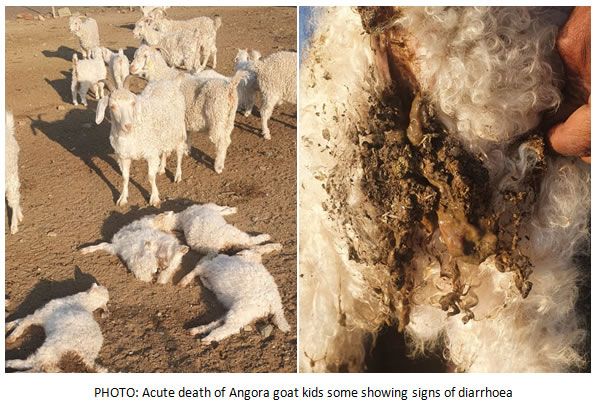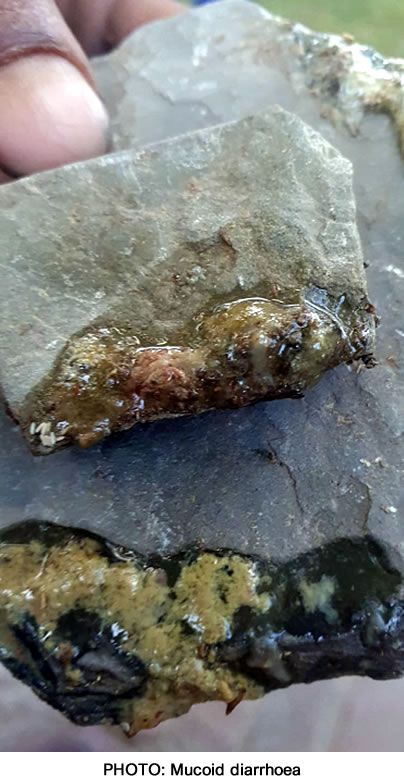Clostridium perfringens C - Necrotic enteritis
By Dr Mackie Hobson BSc(Agric),BVSc
Wednesday, 9th November 2022As Mohair producers we are all familiar with the common Clostridium enterotoxaemia diseases of ‘Pulpy Kidney’,’Bloedpens’ and ‘Rooiderm’ but not with Necrotic enteritis.
Necrotic enteritis has been a less common finding in Angora goats. In sheep toxins produced by Clostridium perfingens types A, B and C may cause necrotic enteritis so in goats the situation may be similar.
The predisposing effects, clinical signs and toxins produced overlap in the clostridium diseases and we should really be referring to the Costridium perfringens diseases as Enterotoxeamia.
It is possible that many more cases of necrotic enteritis may have been going undiagnosed in Angora goats as on macroscopic appearance these may have been attributed to one of the other more common Clostridium perfringens types. However with histopathology it is possible to make a presumptive diagnosis of necrotic enteritis.
What was the background on farms where necrotic enteritis ocurred?
Outbreaks occurred in kids about 2 months old which were kept under intensive kidding conditions. They were adapted to a creep lick feed. Lucern hay was provided but the kids were not really eating it. The ewes had just started to be let out into the veld, returning in the evening to the kids who remained under intensive conditions.
The farmer was suddenly faced with acute deaths with 3 on the first day and continuing daily.
In theory necrotic enteritis is more likely to occur in very young kids in first few weeks of life but adults can also be effected.
Clinical signs.
The farmer reported acute deaths with rapid decomposition. Those dying were the kids in better conditions. There were a few others which looked weaker, some just started diarrhoea with odd one having haemorrhagic (bloody) diarrhoea.

- Acute deaths with 12-48 hrs
- Kids die within a day or two if clinical signs are seen.
- Appear weak and depressed if seen
- Very young kids can pass soft greyish-black faeces or can be bloody (haemorrhagic), can show tetanic spasm when die.
 The sudden onset of neurologic signs followed by sudden death is said to be more common in lambs while kid goats are more likely to show signs of diarrhoea before death.
The sudden onset of neurologic signs followed by sudden death is said to be more common in lambs while kid goats are more likely to show signs of diarrhoea before death.
Adult ewes have diarrhoea (chronic), become weak and recumbent. The clinical progression is seen as longer with the development of hypoproteineamia (in goat ewe dying Albumin was 14g/l. normally >30g/l)
How is the Clostridium transmitted?
Clostridium perfringens C is not considered a normal bacteria of the intestine but is present in carrier animals without causing disease.
- Transmitted per os (by mouth).
- Contamination of feed with faeces
- Environmental contamination with faeces.
- Transmitted by wind/dust.
Pre-disposing factors
- Close confinement, group housing,
- Change in diet (causes change in normal intestinal flora) favours perfringens overgrowth.
- Feeding - Diets high in protein bring about the sharp increase in the clostridium numbers
- Introduced carrier animal.
- Impaired gastric motility increases the clostridium bacteria in the gut
- The presence of foods with high levels of trypsin inhibitors, such as sweet potato and soybeans.
- Concurrent infection with other pathogens or parasites (roundworms or coccidiosis) can change the intestinal environment - favour the proliferation of type C in the intestine.
What toxins (Enterotoxeamia) does C. perfringens C produce?
All Clostridium perfringens type C strains produce alpha and beta toxins. Additionally, certain strains of type C also produce other toxins. Similarly Clostridium perf type A and B can produce alpha and beta toxins so can also be responsible for necrotic enteritis.
How does the necrosis of the intestine occur?
Local production of B toxins in the by rapid increase in the numbers C.perf C causes severe necrosis of mucosa of intestine. Some of the minor toxins cause haemolytic effects to be seen. Clostridia penetrate the damaged epithelium so the damage extends deeper into the submucosa. This damage increases the permeability resulting in toxaemia causing toxic injury, shock and acute death.
Post Mortem findings
- Like the other clostridium enterotoxaemia- rapid autolysis occurs
- Diarrhoea, most without evidence of haemorrhage (mostly duodenum).
- Some transudate into abdomen, pleural and pericardial cavities
- Fibrin over effected intestine mucosa
Histopathology
Histopathological changes in goats consist of acute necrosis of the intestinal mucosa. The small intestine shows loss of Villus structures due to necrosis and lack of mucosal epithelium. Proprial stroma oedematous with superficial necrosis and there is extensive loss and degeneration of cryptal glands. Submucosal lymphoid follicles showing moderate lymphocytolysis . Renal lesions not suggestive of perfringens type D enterotoxaemia)
If goats survive longer then complete loss of the intestinal mucosa is seen as was the case in an adult ewe with chronic diarrhoea and death. In this case cryptal abscesses indicative of necrotic enteritis. Ongoing cases would lead to protein loss.
Diagnosis
On clinical signs, post mortem and histopathology but conformation needs isolation of the bacteria and toxin.
Treatment:
As often acute deaths treatment not possible and kids found dead
- Tube activated charcoal and fluids
- Penicillin antibiotic
- Dose/Tube Pro-biotics, multi-vits
- Goat kids stopped dying when moved into veld with ewes and lucern provided ad lib.
Prevention
Vaccination is critical.
- Vacciante ewes 4-6 weeks before kidding with multiclostridium vaccine.
Which vaccines offer protection against Clostridium perfringens type C (Necrotic enteritis)? See website: https://www.angoras.co.za/article/clostridium-and-pasteurella-vaccines-update#356
- Vaccinate the kids as early as possible before creep feeds and predisposing factors become prevalent.
Some multiclostridium vaccines can be used on kids as young as 1-2 weeks old. See the website: https://www.angoras.co.za/article/when-to-vaccinate-update#354
Remember it is critical the kids receive a second vaccination (usually about a month later depending on the vaccine used)
Attempt to eliminate and prevent predisposing factors.
It is important to get a faecal sample checked when kids have diarrhoea to eliminate coccidiosis, roundworm and tapeworm.
REFERENCES
Infectious diseases of livestock, Coetzer, Thomson, Tustin
Dr Liza du Plessis (IDEXX lab)









